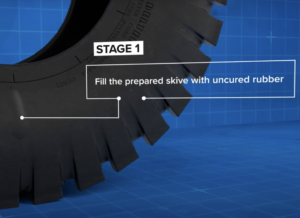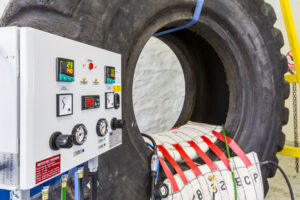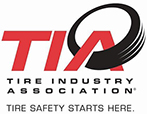Building up the skive - top tips and advice
A key stage in any section repair is filling the skive. We take a look at the different materials and methodologies – what works best and how to create a strong repair.
Stripping stock
 With this method lengths of rubber strip are cut and warmed gently on a heat plate before being stitched into the repair. The process is repeated and layer upon layer of strip rubber gradually fills the skive.
With this method lengths of rubber strip are cut and warmed gently on a heat plate before being stitched into the repair. The process is repeated and layer upon layer of strip rubber gradually fills the skive.
It is essential that you really take the time to carefully and thoroughly roll down each strip and ensure that no air bubbles are trapped.
Rope rubber
A favoured tool of many section repair experts is the extruder. Use a quality extruder to speed up the process and deliver a steady flow of uncured rope rubber exactly where it is needed.
As the rubber passes through the gun it is warmed just enough to reduce the viscosity but not enough to start the curing process.
Stitching to fully eliminate air bubbles is still needed but less extensively than with stripping stock. The benefit here is a much faster application and a reduced risk of air bubbles.
Check the specification of your rope rubber, some manufacturers offer sidewall and tread specific formulations.
Another tip for smooth application is to ensure an even temperature by preheating the tool for 5 to 10 minutes before starting the application.
Don't over fill the skive
If you have previously used spotters to cure your repairs, you may be used to significantly over building the filler rubber in the skive to allow for rubber migration as it’s squeezed out from around the pressure plate. You’ll also typically see this with a spotter due to the repair distortion that occurs around the repair when pressure is exerted in one small location from a fixed angle.
Owing to the larger, more flexible components used in the Monaflex system, the skive is completely covered and held in place in line with the tyre during the cure. This prevents any rubber migration or uncontrolled movement of the filler rubber. Owing to this feature the skive only needs to be slightly over filled. It can be easily buffed back level with the tyre after curing.
This saves time in carrying out the post cure preparation and also provides a stronger, feather edged repair. This method guarantees even pressure is applied to all areas of the skive regardless of its location in the tyre.
Cleanliness is key
 Whatever methodology you prefer, strict workshop cleanliness is essential if you want to achieve optimum repair quality. Contamination is the most common cause of premature repair failure.
Whatever methodology you prefer, strict workshop cleanliness is essential if you want to achieve optimum repair quality. Contamination is the most common cause of premature repair failure.
Whilst cleanliness is always critical when working with raw rubber, it is especially important when using strip stock. The length of time this process takes means there is even more opportunity for contamination via hands, tools, work surfaces and even the atmosphere. Eliminate dust from the workshop as much as possible to minimise any risk of contamination.
Please get in touch for further advice on tyre section repairs.
Any advice given by MVS Ltd. (Monaflex) does not replace instructions supplied by the manufacturer of repair materials, tyres, tools and any other component parts or items in use. It does not replace guidelines, recommendations, usage regulations or any type of requirement stipulated at a company, legislative or any level. Please click here for more information.

